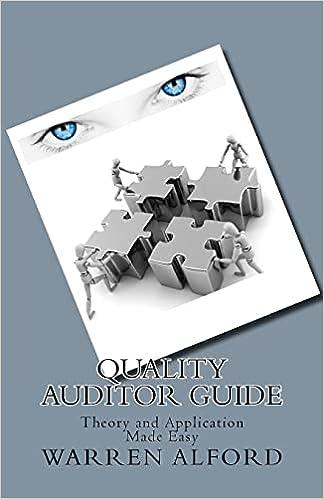Question
Required: Select the best answer for each of the following unrelated questions. 1) Which of the following does NOT apply to the capitalization of borrowing
Required: Select the best answer for each of the following unrelated questions.
1) Which of the following does NOT apply to the capitalization of borrowing costs for the purchase of assets?
a) They can have a significant impact on a company's earnings. b) This is allowed under both ASPE and IFRS. c) This is not allowed under IFRS. d) They must be disclosed in the notes to the financial statements.
2) Under ASPE, the costs for environmental clean-up at the end of an assets useful life a) are always expensed as incurred. b) are recognized only if they represent a legal obligation. c) are capitalized once they have become apparent.
d) include only costs related to the acquisition of the asset.
3) When a closely held corporation issues preferred shares for land, the land should be recorded at the
a) total value of the shares issued. b) total book value of the shares issued. c) total liquidating value of the shares issued.
d) fair market value of the land.
4) A principal objection to the straight-line method of depreciation is that it a) provides for the declining productivity of an aging asset. b) ignores variations in the rate of asset use. c) tends to result in a constant rate of return on a diminishing investment base.
d) gives smaller periodic write-offs than decreasing charge methods.
5) IFRS require that assets must be assessed for indications of impairment a) at the end of every quarter. b) at the end of each reporting period. c) when events and circumstances indicate that asset's carrying amount may not be recoverable. d) whenever the method of depreciation has changed.
6) Which of the following is NOT likely to be an indicator of possible asset impairment? a) evidence of obsolescence or physical damage b) a significant decrease in the asset's market value c) the book value of the entitys net assets is greater than the entitys marketcapitalization d) costs incurred for asset acquisition or construction are significantly lower than originally expected
7) Which of the following best describes goodwill? a) internal value generated by way of a brand image b) the excess of fair value transferred to acquire a business over fair value amounts
assigned to identifiable assets c) internal value generated by way of a companys charitable activities and philanthropic acts d) a companys intentions to impact the community and environment in a favourable way
8) When determining whether an internally developed intangible asset should be recognized, the process of generating the intangible is usually broken down into the
a) research and financing elements.
b) acquisition and disposal stages. c) exploitation and disposal stages.
d) research and development phases.
9) Under ASPE, which of the following statements best describes the accounting for intangible assets after acquisition?
a) They may be accounted for under the cost model or the revaluation model. b) They should be accounted for under the cost model. c) They should be accounted for under the revaluation model. d) They must be amortized over a very short period, usually less than five years.
10) Under IFRS, which of the following statements best describes the accounting for intangible assets after acquisition?
a) They may be accounted for under either the cost model or the revaluation model. b) They should be accounted for under the cost model. c) They should be accounted for under the revaluation model if an active market exists
for the asset. d) They should always be accounted for under the revaluation model.
Step by Step Solution
There are 3 Steps involved in it
Step: 1

Get Instant Access to Expert-Tailored Solutions
See step-by-step solutions with expert insights and AI powered tools for academic success
Step: 2

Step: 3

Ace Your Homework with AI
Get the answers you need in no time with our AI-driven, step-by-step assistance
Get Started


